Imagine soaking in a natural hot spring, surrounded by the breathtaking beauty of Colorado‘s mountains and forests. Sounds enticing, right? Well, we’ve got good news for you! Colorado is home to some of the most rejuvenating natural hot springs in the country. This offers the perfect blend of relaxation, adventure, and health benefits.
In this article, we dive into the fascinating world of hot springs. We reveal the three best natural hot springs locations in Colorado. Further, we explore how they’re formed and why Colorado is a hot springs paradise.
Ready to take the plunge? Let’s go!
1. Conundrum Hot Springs
Welcome to Conundrum Hot Springs, a true gem nestled in the Maroon Bells-Snowmass Wilderness, offering an unforgettable experience for those who love a little adventure with their relaxation.
Hiking to the Hot Springs
Get ready to lace up your hiking boots! To reach Conundrum Hot Springs, you’ll embark on an 8.5-mile hike, starting from the Conundrum Creek Trailhead. The scenic journey takes you through:
- Lush forests
- Meadows dotted with wildflowers
- A breathtaking view of the surrounding peaks
Remember, the challenge is all part of the adventure!
Soaking at an Elevation
At an 11,200-foot elevation, Conundrum Hot Springs is North America’s highest natural hot spring. Imagine soaking in the warm, mineral-rich waters while marveling at the panoramic views of the surrounding alpine landscape. Pure bliss awaits you.
Camping Overnight
To fully appreciate the magic of Conundrum Hot Springs, consider camping overnight. There are designated campsites near the springs. But be sure to obtain a permit in advance, as they’re required between June 1 and September 1. Don’t forget to practice Leave No Trace principles to preserve this incredible location for future generations.
Best Time to Visit
Although Conundrum Hot Springs is accessible year-round, the best time to visit is during the summer and early fall when the trail is snow-free, and the weather is more predictable. Remember that afternoon thunderstorm are common, so it’s wise to start your hike early in the day.
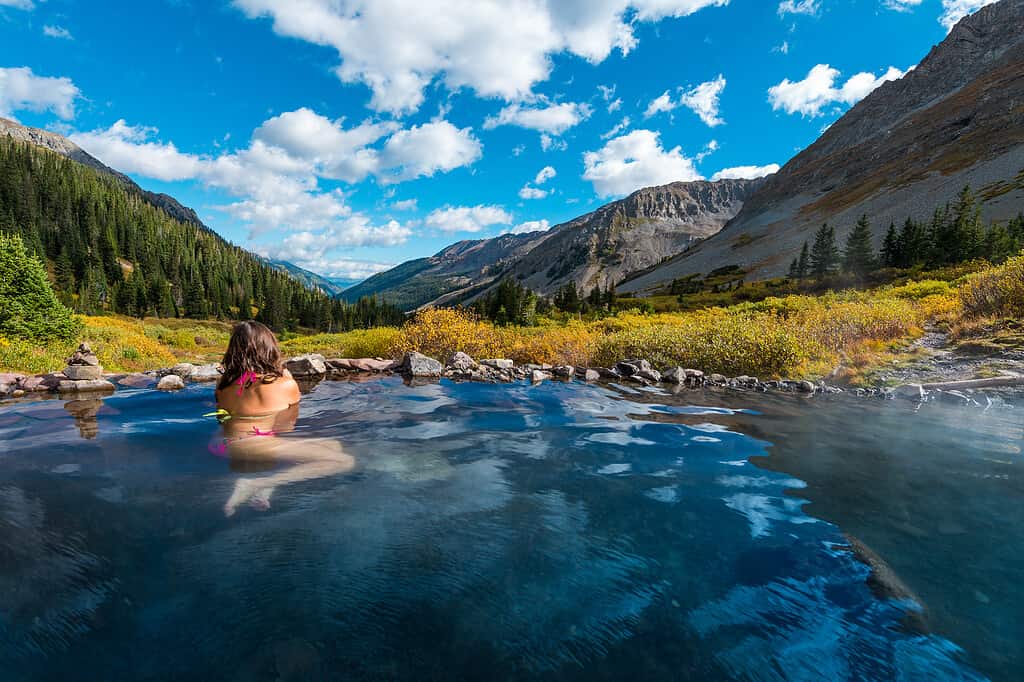
At an 11,200-foot elevation, Conundrum Hot Springs is North America’s highest natural hot spring.
©Kris Wiktor/Shutterstock.com
2. Strawberry Park Hot Springs
Get ready to experience Strawberry Park Hot Springs. At this magical destination, nature’s beauty and relaxation come together in perfect harmony, just a short drive from the charming town of Steamboat Springs.
Rustic Charm and Relaxation
Nestled among the aspen and pine trees, Strawberry Park Hot Springs offers a rustic, serene setting to unwind. With several pools ranging from 101°F to 105°F, you can find the perfect temperature to soak away your stress while surrounded by the beauty of the Colorado wilderness.
Unique Accommodations
Strawberry Park Hot Springs isn’t just about soaking in the warm waters; it also offers unique lodging options for a memorable overnight stay. Choose from various accommodations, including rustic cabins, covered wagons, and even a renovated train caboose, for a truly unforgettable experience.
Activities Galore
In addition to soaking in the hot springs, you can explore many outdoor activities around Strawberry Park. In the winter, enjoy snowshoeing, cross-country skiing, or a horse-drawn sleigh ride. When the snow melts, hiking, mountain biking, and wildlife watching are all popular activities in the area.
A Soothing Experience for All Ages
Strawberry Park Hot Springs is a family-friendly destination, making it a great spot for visitors of all ages. During the day, kids can splash around in the cooler swimming pool, while adults can enjoy the therapeutic waters. Just remember that after dark, the hot springs are reserved for visitors 18 and older, allowing for a more tranquil experience.
Plan Your Visit
Strawberry Park Hot Springs is open year-round. But be prepared for the changing mountain weather conditions. Four-wheel drive vehicles or chains are recommended during the winter months. Reservations are required for both day visits and overnight stays, so be sure to book in advance.
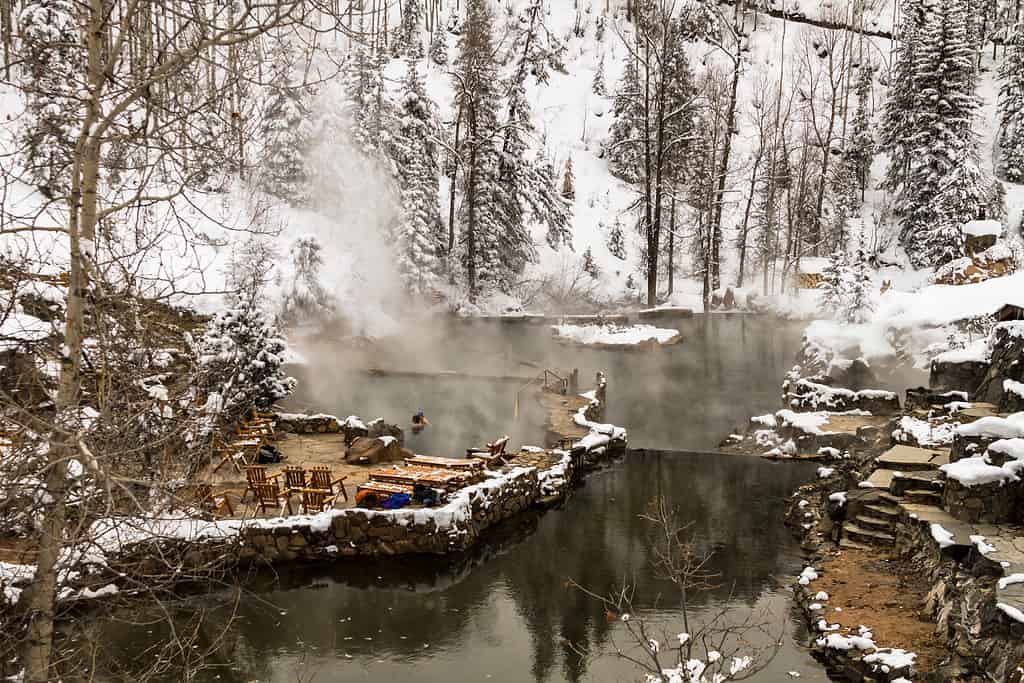
Nestled among the aspen and pine trees, Strawberry Park Hot Springs offers a rustic, serene setting to unwind.
©Teri Virbickis/Shutterstock.com
3. Radium Hot Springs
Discover Radium Hot Springs, a hidden gem tucked away along the banks of the Colorado River. Here, you can bask in the warm waters and marvel at the stunning canyon views. Ready for a little off-the-beaten-path adventure?
A Scenic Riverside Soak
Radium Hot Springs is a small, natural hot spring located right beside the Colorado River. As you soak in the warm waters, you’ll be treated to a peaceful, picturesque setting with the river flowing by and the canyon walls surrounding you. It’s the perfect spot for a secluded, restorative experience.
A Moderate Hike to Reach the Springs
Getting to Radium Hot Springs requires a bit of effort, but it’s well worth it. From the Mugrage Campground parking area, you’ll hike about a mile along the well-marked trail, taking in the beautiful scenery and breathing in the fresh mountain air. Once you reach the springs, you’ll find a small pool nestled in the rocks, waiting for you to enjoy.
The Perfect Pit Stop
Radium Hot Springs makes for an ideal pit stop while exploring the surrounding area. Whether you’re rafting down the Colorado River or hiking nearby trails, this little oasis provides the perfect opportunity to relax, recharge, and enjoy the tranquil setting.
A Few Things to Keep in Mind
As Radium Hot Springs is a small, undeveloped location, there are no facilities or amenities nearby. Be prepared to pack in and pack out everything you need for your visit, and practice Leave No Trace principles to help preserve this beautiful spot for future visitors. Also, be aware that the water temperature can fluctuate depending on the time of year and river levels.
When to Go
Radium Hot Springs can be visited year-round. But spring, summer, and fall are the most popular times, as the weather is more predictable and the surrounding trails are accessible. During the winter months, the springs can still be reached. But be prepared for colder temperatures and icy conditions.
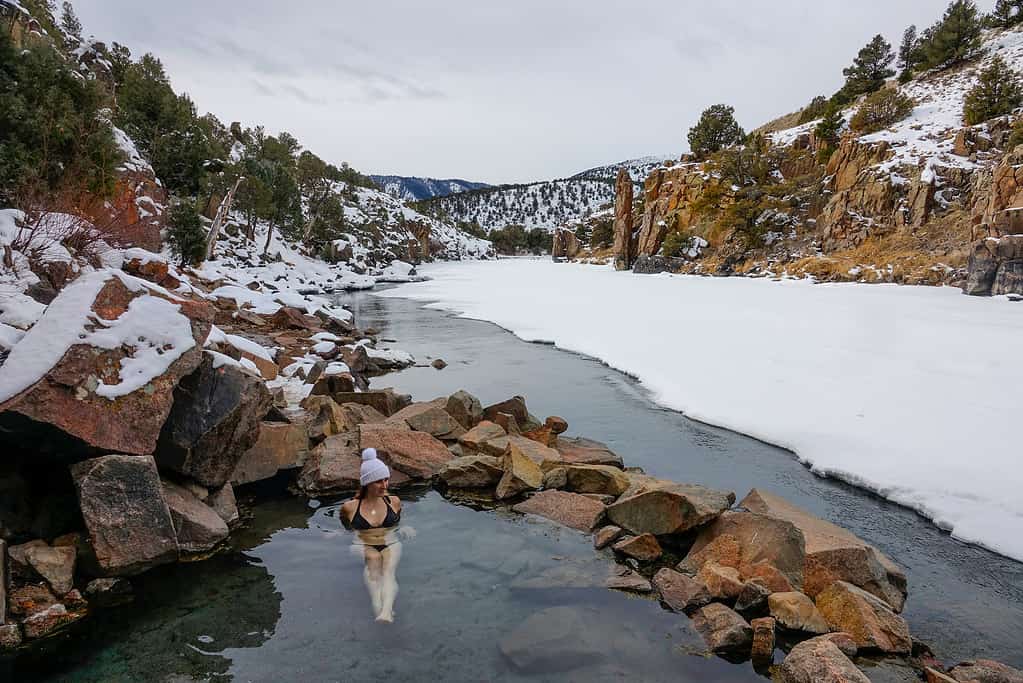
Radium Hot Springs is a small, natural hot spring located right beside the Colorado River.
©Flystock/Shutterstock.com
How Are Hot Springs Formed?
Have you ever wondered how hot springs came to be? These naturally occurring wonders are more than just beautiful places to relax and unwind; they’re also fascinating geological phenomena that offer a glimpse into the Earth’s inner workings.
The Role of Earth’s Magma
Deep below the Earth’s surface, a molten rock known as magma heats the surrounding rock layers, creating intense heat. This heat is a crucial ingredient in the formation of hot springs, as it raises the temperature of underground water sources.
Water Heating and Circulation
Rainwater and melting snow can seep into the ground, making their way through porous rocks and fissures until they reach the heated layers near magma. As the water becomes hotter, it begins to rise back to the surface, bringing with it the dissolved minerals and warmth that create hot springs.
Minerals: The Secret Ingredient
The minerals dissolved in the water are what make hot springs unique and beneficial. As the heated water rises through the Earth’s layers, it gathers calcium, sulfur, and magnesium minerals. These minerals give hot springs their distinct characteristics, including their color, odor, and potential health benefits.
The Emergence of Hot Springs
When the heated, mineral-rich water reaches the surface, it can create pools, geysers, or fumaroles, depending on the geological conditions of the area. For example, hot springs often emerge in regions with volcanic activity or where there are faults in the Earth’s crust, allowing the water to reach the magma-heated layers more easily.
Temperature Variations
Hot springs can range in temperature from lukewarm to scalding hot, depending on various factors, including:
- The depth of the water source
- The rate of heat transfer
- The distance from the magma
Some hot springs have temperatures that are comfortable for soaking, while others are too hot and can be dangerous.
Why Do Hot Springs Occur in Colorado?
Colorado is known for:
- Its picturesque mountains
- Thrilling outdoor adventures
- Its numerous hot springs
But what makes the Centennial State such a hotbed for these natural wonders? Let’s explore the geological factors that contribute to the abundance of hot springs in Colorado.
The Rocky Mountains: A Key Contributor
The majestic Rocky Mountains play a significant role in the presence of hot springs in Colorado. Formed millions of years ago, these mountains are the result of powerful tectonic forces that created numerous fault lines and fractures in the Earth’s crust. These geological formations provide the necessary pathways for water to reach the magma-heated layers deep underground.
Volcanic Activity in Colorado’s Past
Though Colorado is not currently volcanically active, its geologic history includes periods of volcanic activity. The remnants of ancient volcanoes, such as the La Garita Caldera and the Dotsero Crater, serve as evidence of this volcanic past. This history contributes to the presence of hot springs in the region, as areas with volcanic activity are more likely to have the necessary heat sources for the formation of hot springs.
The Abundance of Groundwater
Colorado’s diverse climate and abundant snowfall contribute to the ample supply of groundwater needed for the formation of hot springs. The melting snow and rainwater percolate into the ground, where they can be heated by the Earth’s inner warmth before returning to the surface as hot springs.
A Variety of Hot Springs
The unique combination of Colorado’s geology, climate, and hydrology has resulted in many hot springs, each with its own distinct characteristics. Colorado offers something for every hot spring enthusiast, from the soothing waters of Strawberry Park Hot Springs to the invigorating soak at Conundrum Hot Springs.
A Geological Gift
Ultimately, the abundance of hot springs in Colorado is a testament to the state’s remarkable geological history and diverse natural resources. These natural wonders not only provide relaxation and rejuvenation but also serve as a reminder of the incredible forces that have shaped our planet over millions of years.
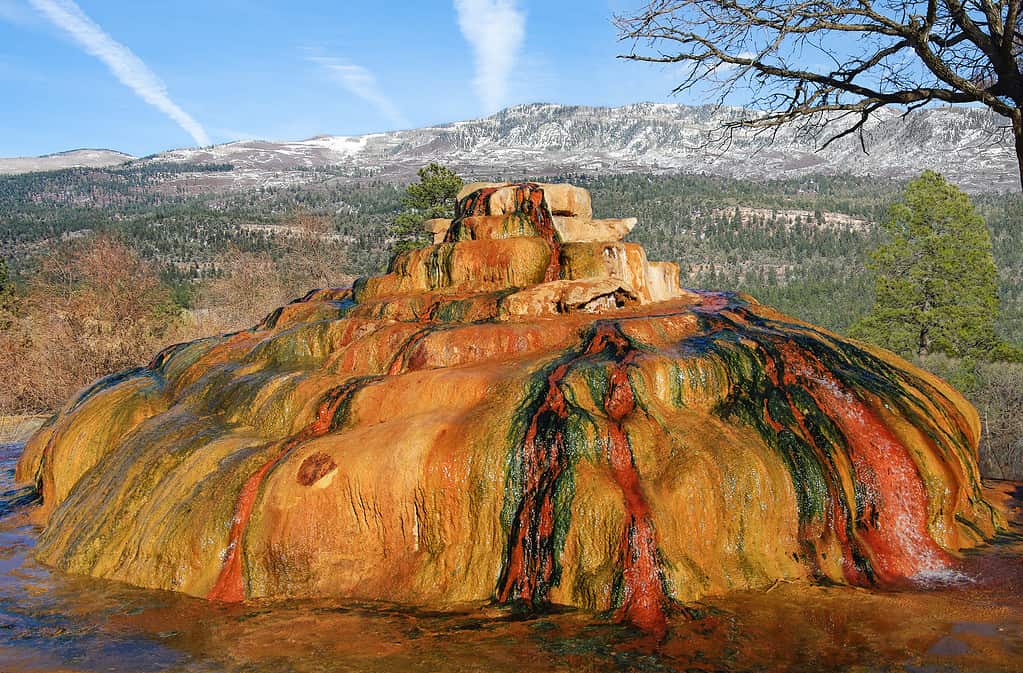
Colorado Hot Springs: Geothermal activity creates colorful mineral deposits at the Pinkerton Hot Springs in southwest Colorado.
©Earl D. Walker/Shutterstock.com
Are Hot Springs Safe to Swim In?
As you dip your toes into the warm, soothing waters of a hot spring, you might wonder: are hot springs safe to swim in? While these natural spas can offer numerous health benefits and relaxation, it’s essential to be aware of certain safety considerations before taking the plunge.
Temperature: Finding the Right Balance
Among the most critical factors in determining whether a hot spring is safe to swim in is its temperature. Ideally, the water should be comfortably warm, ranging from 98°F to 104°F. Anything hotter than this can be dangerous, increasing the risk of burns or heat-related illnesses. Be sure to test the water with your hand before entering, and always listen to your body’s signals.
Bacterial Concerns: Staying Safe
While many hot springs contain minerals with potential health benefits, they can also harbor harmful bacteria, such as Legionella or Naegleria fowleri. To minimize your risk, avoid submerging your head or swallowing the water, and steer clear of springs with stagnant water or an unpleasant odor. In addition, if you have any open wounds, cuts, or a weakened immune system, it’s best to consult a healthcare professional before taking a dip.
Natural Hazards: Being Aware of Your Surroundings
The natural environment surrounding hot springs can present its own set of hazards, such as slippery rocks, steep banks, or strong currents. Exercise caution when entering and exiting the water, and be mindful of any potential dangers in the area.
Supervision: A Key to Safety
If you’re visiting a hot spring with children or inexperienced swimmers, providing constant supervision is essential. The combination of warm water and unfamiliar surroundings can be disorienting, so it’s crucial to keep an eye on your loved ones at all times.
Know Before You Go: Research and Preparation
Before visiting a hot spring, take the time to research the specific location, its water temperature, and any potential hazards. Many hot springs are managed by parks or resorts, which may provide additional information on their websites or at the site itself. Being prepared and informed will help ensure a safe and enjoyable hot spring experience.
Other Local Attractions in Colorado
While Colorado’s hot springs are undoubtedly a major draw for visitors, the state offers many other attractions worth exploring. From breathtaking national parks to vibrant cities, Colorado boasts a diverse range of experiences that cater to every traveler’s interests.
National Parks and Monuments
Colorado is home to several awe-inspiring national parks and monuments that showcase the state’s diverse landscapes. Marvel at the towering sandstone formations in Garden of the Gods, explore the ancient cliff dwellings of Mesa Verde National Park, or hike through the striking wilderness of Rocky Mountain National Park.
Thrilling Outdoor Activities
For those seeking adventure, Colorado is a playground of outdoor pursuits, thanks to ski or snowboard in world-class resorts like Aspen, Vail, or Breckenridge. For adrenaline-pumping summer activities, try white-water rafting on the Arkansas River, mountain biking in Fruita, or rock climbing in Eldorado Canyon State Park.
Vibrant Cities and Cultural Experiences
Colorado’s cities offer a rich tapestry of cultural experiences. Immerse yourself in the thriving arts scene of Denver, indulge in craft beer tours in Fort Collins, or catch a live performance at the stunning Red Rocks Amphitheatre in Morrison. History buffs will love exploring the gold rush history of Central City and the Colorado Railroad Museum in Golden.
Scenic Drives and Byways
Experience the beauty of Colorado’s landscapes through its scenic drives and byways. The iconic Trail Ridge Road in Rocky Mountain National Park takes you above the tree line for breathtaking views, while the San Juan Skyway loops through picturesque mountain towns like Ouray and Telluride. For a taste of Colorado’s wine country, follow the Palisade Fruit and Wine Byway.
Charming Mountain Towns
Nestled among Colorado’s majestic mountains are many charming towns that offer a taste of the state’s history and hospitality. Discover the Victorian charm of Georgetown, take a scenic train ride in Durango, or soak in the laid-back vibe of Crested Butte.
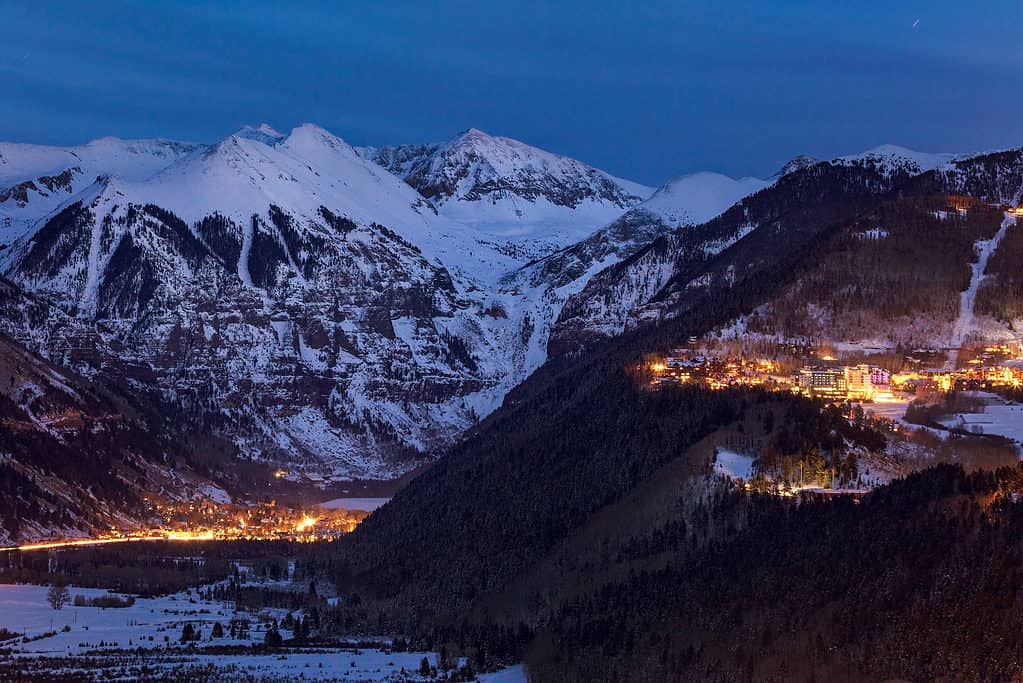
Telluride, San Juan Mountains, Colorado.
This state is known for its picturesque mountains and thrilling outdoor adventures.
©iStock.com/mdesigner125
Key Takeaways
We’ve journeyed through the stunning landscapes of Colorado and discovered the three best natural hot springs, each with its own unique charm and rejuvenating properties.
It’s time to start planning your own adventure, immerse yourself in these geothermal wonders, and experience the healing benefits first-hand. Also, don’t forget to explore the other fantastic attractions Colorado has to offer, from national parks to cultural experiences.
The photo featured at the top of this post is © Flystock/Shutterstock.com
Thank you for reading! Have some feedback for us? Contact the AZ Animals editorial team.






